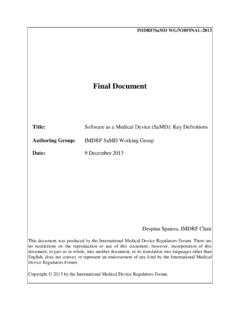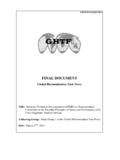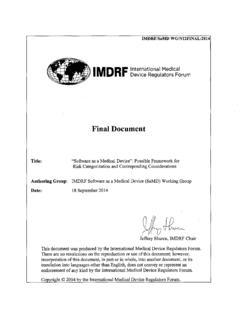Transcription of GHTF SG5 Clinical Performance Studies for IVD Medical …
1 GHTF/SG5/N8:2012 FINAL DOCUMENT Global Harmonization Task Force Title: Clinical Evidence for IVD Medical Devices - Clinical Performance Studies for In Vitro Diagnostic Medical Devices Authoring Group: Study Group 5 of the Global Harmonization Task Force Date: November 2nd, 2012 Dr. Kazunari Asanuma, GHTF Chair This document was produced by the Global Harmonization Task Force, a voluntary international group of representatives from Medical device regulatory authorities and trade associations from Europe, the United States of America (USA), Canada, Japan and Australia. The document is intended to provide non-binding guidance to regulatory authorities for use in the regulation of Medical devices, and has been subject to consultation throughout its development. There are no restrictions on the reproduction, distribution or use of this document; however, incorporation of this document, in part or in whole, into any other document, or its translation into languages other than English, does not convey or represent an endorsement of any kind by the Global Harmonization Task Force.
2 Copyright 2012 by the Global Harmonization Task Force Clinical Evidence for IVD Medical Devices - Clinical Performance Studies for In Vitro Diagnostic Medical Devices Study Group 5 Final Document GHTF/SG5/N8:2012 November 2nd, 2012 Page 2 of 21 Table of Contents Introduction ..4 Scope ..4 References ..5 Definitions ..5 Purpose of Clinical Performance Studies ..5 Clinical Performance Study Design Type ..6 Observational Designs .. 7 Cross-sectional Designs ..8 Longitudinal Designs ..8 Retrospective and Prospective Designs ..9 Interventional Designs .. 10 Clinical Performance Study Design Considerations .. 11 Test purpose .. 12 Specimen Collection and Handling .. 12 Clinical Performance Study Site Location .. 13 Statistical 13 Potential Risks .. 14 Ethical Considerations for Clinical Performance Studies .. 14 Informed Consent .. 15 Ethics Committee Involvement .. 15 Communicating Test Results Outside of the Study.
3 15 Clinical Performance Study Protocol .. 16 Conduct of Clinical Performance Studies .. 16 Clinical Performance Study Report .. 17 Appendix .. 18 Clinical Evidence for IVD Medical Devices - Clinical Performance Studies for In Vitro Diagnostic Medical Devices Study Group 5 Final Document GHTF/SG5/N8:2012 November 2nd, 2012 Page 3 of 21 Preface The document herein was produced by the Global Harmonization Task Force, a voluntary group of representatives from Medical device regulatory agencies and the regulated industry. The document is intended to provide non-binding guidance for use in the regulation of Medical devices, and has been subject to consultation throughout its development. There are no restrictions on the reproduction, distribution or use of this document; however, incorporation of this document, in part or in whole, into any other document, or its translation into languages other than English, does not convey or represent an endorsement of any kind by the Global Harmonization Task Evidence for IVD Medical Devices - Clinical Performance Studies for In Vitro Diagnostic Medical Devices Study Group 5 Final Document GHTF/SG5/N8:2012 November 2nd, 2012 Page 4 of 21 Introduction When placing an IVD Medical device on the market the manufacturer must have demonstrated through the use of appropriate conformity assessment procedures that the device complies with GHTF s Essential Principles of Safety and Performance of Medical Devices (EPs).
4 As IVD Medical devices are used for the examination of specimens derived from the human body, the characteristics of Clinical evidence are different from Medical devices other than IVD Medical devices. Generally, from a Clinical perspective, it is expected that the manufacturer has demonstrated the IVD Medical device achieves its intended Performance during normal conditions of use by the intended user in the intended environment ( laboratories, physician s offices, healthcare centers, home environments) and in the intended use population. The objective of a Clinical Performance study is to evaluate whether the IVD Medical device is suitable ( meets the relevant Essential Principles of Safety and Performance ) for the purpose(s) and the population(s) for which it is intended, when this cannot be addressed with the analytical Performance data, literature and/or experience gained by routine diagnostic testing. In general, Clinical Performance Studies must be designed according to, and take into account scientific principles underlying the collection of Clinical Performance data along with accepted operational and ethical standards surrounding the use of human subjects.
5 The Clinical Performance study objectives and design should be documented in a Clinical Performance study protocol. The data collection process must ensure patient safety and data integrity along the entire process of the study. Scope The primary purpose of this document is to provide guidance for manufacturers of IVD Medical devices, Regulatory Authorities (RA) and Conformity Assessment Bodies (CAB) in relation to: the selection of a Clinical Performance study design considerations to be made when undertaking a Clinical Performance study; and protocol, conduct and report of a Clinical Performance study Given the wide diversity of IVD Medical devices and their associated risks, this document is not intended to provide comprehensive guidance for Clinical Performance Studies of specific IVD Medical devices. Clinical Performance Studies are typically performed in the pre-market phase. However, this document may also apply to Studies conducted in the post-market phase.
6 NOTE: This document should not be used in isolation but read together with the documents Clinical evidence for IVD Medical devices Key Definitions and Concepts and Clinical evidence for IVD Medical devices Scientific Validity Determination and Performance Evaluation as well as the document Essential Principles of Safety and Clinical Evidence for IVD Medical Devices - Clinical Performance Studies for In Vitro Diagnostic Medical Devices Study Group 5 Final Document GHTF/SG5/N8:2012 November 2nd, 2012 Page 5 of 21 Performance of Medical Devices and the document Summary Technical Documentation (STED) for Demonstrating Conformity to the Essential Principles of Safety and Performance of In Vitro Diagnostic Medical Devices (references provided in the reference section). References GHTF/SG1/N071:2012 Information Document Concerning the definition of the Term Medical Device GHTF/SG1/N068:2012 Essential Principles of Safety and Performance of Medical Devices GHTF/SG1/N45:2008 Principles of In Vitro Diagnostic Medical Devices Classification.
7 GHTF/SG1/N046:2008 Principles of Conformity Assessment for in vitro Diagnostic (IVD) Medical Devices GHTF/SG1/N063:2011 Summary Technical Documentation (STED) for Demonstrating Conformity to the Essential Principles of Safety and Performance of In Vitro Diagnostic Medical Devices GHTF/SG5/N6:2012 Clinical Evidence for IVD Medical Devices Key Definitions and Concepts GHTF/SG5/N7:2012 Clinical Evidence for IVD Medical Devices Scientific Validity Determination and Performance Evaluation World Medical Association Declaration of Helsinki - Ethical principles for Medical research involving human subjects Definitions Clinical Performance Study Protocol Document that states the rationale, objectives, design and proposed analysis, methodology, monitoring, conduct and record-keeping of the Clinical Performance study. IVD Medical device Refer to GHTF/SG1/N71:2012 definition of the Terms Medical Device and In Vitro Diagnostic (IVD) Medical Device.
8 Purpose of Clinical Performance Studies The purpose of a Clinical Performance study is to establish or confirm aspects of IVD Medical device Performance which cannot be determined by analytical Performance Studies , literature and/or previous experience gained by routine diagnostic testing. This information is used to demonstrate compliance with the relevant Essential Principles with respect to Clinical Performance . When a Clinical Performance study is conducted, the data obtained is used in the Performance evaluation process and is part of the Clinical evidence for the IVD Medical device Clinical Evidence for IVD Medical Devices - Clinical Performance Studies for In Vitro Diagnostic Medical Devices Study Group 5 Final Document GHTF/SG5/N8:2012 November 2nd, 2012 Page 6 of 21 (see GHTF SG5/N7 Clinical Evidence for IVD Medical devices Scientific Validity Determination and Performance Evaluation ). These Studies are typically undertaken in the pre-market phase of the IVD Medical device to support its compliance with the EPs, but may also be undertaken in the post-market phase.
9 Clinical Performance Study Design Type Clinical Performance Studies should be designed in such a way as to maximize the relevance of the data while minimizing potential biases. Designs of IVD Medical device Clinical Performance Studies are either observational or interventional. An observational study refers to a study in which test results obtained during the study are not used for patient management and do not impact treatment decisions. An interventional study refers to a study in which test results obtained during the study may influence patient management decisions and may be used to guide treatments. Observational design can be further characterized as a combination of the following designs: Cross-sectional design (single time-point design) testing of one or few specimens/samples per patient that are collected at a single time-point Longitudinal design testing of multiple specimens/samples per patient that are collected over an extended period of time ( weeks, months, years) Retrospective design testing of previously collected specimens for which the analyte status and the patient s Clinical status is known (characterized specimens) prior to the commencement of the study Prospective design testing of specimens collected before or during the study but for which both the analyte status and the patient s Clinical status are established during the study Prospective-retrospective design testing of previously collected specimens for which the Clinical status is known but the analyte status is unknown and will be established during the study NOTE.
10 The terminology for the various study designs can be used in the context of either diagnostic or epidemiologic Studies , and these terms are associated with definitions that vary accordingly. The definitions and methodologies described in this document refer to diagnostic test designs, not epidemiological designs. Figure 1 provides an illustration of the use of study design types for a single test purpose. Further clarifications on these study design types are presented below. Clinical Evidence for IVD Medical Devices - Clinical Performance Studies for In Vitro Diagnostic Medical Devices Study Group 5 Final Document GHTF/SG5/N8:2012 November 2nd, 2012 Page 7 of 21 Figure 1: Decision tree for Clinical Performance study design NOTE: In some cases it may be necessary to use a combination study design which includes both characterized and uncharacterized specimens. Observational Designs The majority of IVD Medical device Clinical Performance Studies follow an observational design.












